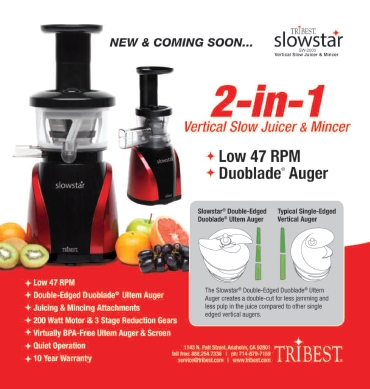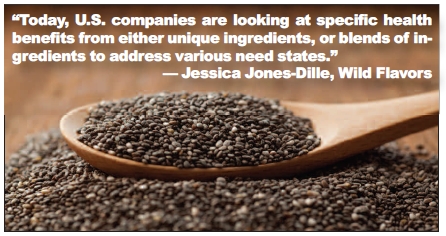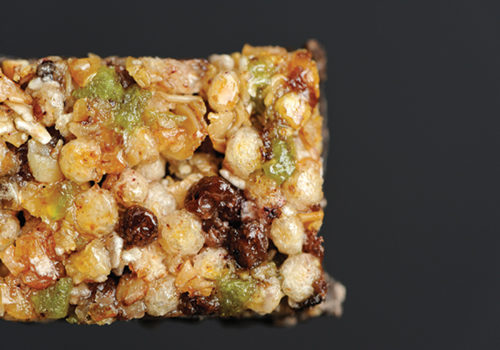Healthy foods should all be functional to a certain extent; fatty fish deliver omega-3s and oranges are packed with vitamin C. So, what makes certain products “functional foods,” and how are your shoppers shaping the functional foods and beverages market?
A Functional Definition
Functional foods don’t have a legal definition. Nonetheless, many products are crowned “functional” when they are enriched or enhanced in some way to offer additional health benefits.
The definition gets more complicated when functional beverages walk a fine line between liquid supplements and foods. The U.S. Food and Drug Administration (FDA) has had its eye on this issue, and, in 2009, disseminated a draft guidance on some distinguishing factors between the two camps.
Until a final guidance is issued, Heather Biehl, associate director of H.I.T.S., Wild Flavors, Erlanger, KY, says there are ways to tell what FDA is thinking on the matter. “It’s through FDA’s actions and warning letters that we will get clues on how they will regulate liquid supplements and functional beverages,” she states.
In 2012, several warning letters were issued. In one case, a coffee/energy product was labeled as a supplement, but FDA felt it was a beverage because of its name, packaging (which includes its size) and overall look (1). The main reason why you should care about FDA’s thinking in this area is that beverage ingredients should either have generally recognized as safe (GRAS) status or be an approved food additive. The warning letter to the coffee/energy drink manufacturer indicated it used ginkgo, which is neither GRAS nor an approved food additive. If manufacturers are using a category’s loopholes to get an ingredient on the shelf, be leery of it.
We had several quiet months without FDA sending warning letters about beverage versus supplement marketing. Then in April 2013, Natures Health Options received a letter partly for its Charantea Bitter Melon Ampalaya tea bags sold as supplements. The letter indicated this is an inappropriate label because the manufacturer represents the tea as a conventional food with statements like, “Instead of coffee or sugary drinks to cap your meals, make Charantea your healthy after-meal beverage.”
This letter could be a signal that FDA is once again turning its attention to straightening out when a functional beverage is a beverage and not a supplement. While some are hopeful for a final guidance, others feel FDA shouldn’t regulate the functional foods/beverage area too stringently.
“We have entered a new era where science can validate very safe but highly effective food choices (whether compounds or whole foods), yet the FDA’s orientation and perspective are built on a pharmaceutical approach,” states Peter Leighton, CEO of Abunda Functional Foods, San Francisco, CA. “As long as we know the scientific facts about the beneficial effects of these functional compounds, we must be able, even required, to communicate these facts. But, the FDA perspective is to try and force our industry into the pharma model with the thinking, ‘If these natural compounds are so beneficial then prove them just like a therapeutic does.’”
If a final guidance does come through, Biehl hopes the agency doesn’t impose stricter regulations on functional foods and beverage makers. “It’s a key segment in helping the nation improve and maintain their health and wellness,” she believes, and she wouldn’t want to see these efforts limited.
Consumer Drivers
The functional food/beverage category is continually evolving, but one steady market driver is health-conscious consumers. States Michael Arlen, president of NEWtritious, LLC, Los Angeles, CA, “The old adage, ‘You are what you eat,’ though not literally true, definitely embodies today’s consumer’s understanding of the importance of what he or she decides to ingest.”
Michael Bush, vice president of business development at Ganeden Biotech, Cleveland, OH, suggests the momentum toward functional foods is partly due to the rise in sickness. “Consumers are becoming increasingly aware of how foods can assist in managing their health,” he states.
Thus, shoppers are gravitating toward natural, minimally processed functional foods because they want every last bang for their nutritional buck. In other words, why drink plain old milk when you can have milk with added DHA?
Bush cites some interesting data collected by the International Food Information Council: “Eighty seven percent agree with the concept of ‘functional foods’—that certain foods have health benefits beyond basic nutrition. Ninety percent can name a food and its associated health benefit.”
 The interest in functional products indicates a more educated consumer than we may have seen several years ago. “We are seeing an increase in the demand for fruits, vegetables and healthy grains and fibers in the form of whole food powders,” says Hartley Pond, vice president of technical sales at VDF/FutureCeuticals, Momence, IL. “Our customers are looking for clean and simple ingredient declarations that contain products grown on American farms.”
The interest in functional products indicates a more educated consumer than we may have seen several years ago. “We are seeing an increase in the demand for fruits, vegetables and healthy grains and fibers in the form of whole food powders,” says Hartley Pond, vice president of technical sales at VDF/FutureCeuticals, Momence, IL. “Our customers are looking for clean and simple ingredient declarations that contain products grown on American farms.”
Biehl believes the upswing in health consciousness may have something to do with concerns about future access to healthcare. “[Shoppers] are unsure and uneasy about insurance coverage and access to doctors. They are also concerned about the rising costs of healthcare,” she states. “This has led consumers to take alternative approaches to health and wellness.”
Thus, to keep down medical costs and a reliance on treatments, consumers are looking for ways to make smart and healthy dietary changes such as incorporating functional foods and beverages into their daily routines. “The key driver is being able to deliver a ‘lifestyle antidote,’ or a solution for the problems our lifestyle is causing us,” states Leighton.
The functional foods and beverages market is expanding, but this doesn’t mean all products are on the up and up. “Even highly processed foods are advertising health claims and added benefits these days. It’s not as easy to choose functional foods when nearly all products are advertised as such,” warns Janie Hoffman, CEO and founder of Mamma Chia, Bonsall, CA. “With consumers becoming more and more educated, it is important for companies to offer high-quality products that fulfill their promise.”
Arlen agrees, noting that artificial flavors, colors, sweeteners and preservatives have become mainstream preoccupations with educated consumers. Use this to your advantage in your marketing efforts and when you reach out to shoppers. Remember, shoppers are increasingly label readers, says Jim May, founder and president of SweetLeaf Stevia, Wisdom Natural Brands, Gilbert, AZ, “ A few years ago, these consumers were considered outside of the mainstream. Today, they are the predominant force,” he says.
So, combat the highly processed foods with  “health” claims (e.g., a kids’ cereal that is 41% its weight in sugar yet labeled as a smart choice for shoppers because it is boosted with vitamins A and C) with proof of a product’s functionality. Shoppers will thank you for it. States Arlen, “[Informed consumers] want to see scientific clinical data (not just marketing trials), where a statistically significant group has been tested in at least two double-blind, placebo-controlled clinical trials, yielding a sound confirmation that the product works.” As a bonus, if there’s research on the finished product or key branded ingredient, shoppers are smart enough to know that that’s even better than a more general study.
“health” claims (e.g., a kids’ cereal that is 41% its weight in sugar yet labeled as a smart choice for shoppers because it is boosted with vitamins A and C) with proof of a product’s functionality. Shoppers will thank you for it. States Arlen, “[Informed consumers] want to see scientific clinical data (not just marketing trials), where a statistically significant group has been tested in at least two double-blind, placebo-controlled clinical trials, yielding a sound confirmation that the product works.” As a bonus, if there’s research on the finished product or key branded ingredient, shoppers are smart enough to know that that’s even better than a more general study.
Overall, the take home message is that people want real, healthy food that is truly functional, says Kristen Buchanan, C.N., founder and CEO of The GoodOnYa Bar, Encinitas, CA, and that shoppers are not willing to be duped. She states, “When we demo and sample our products, we don’t have to explain what things are; they understand each ingredient, they can make it in their kitchen and they don’t need a lab.”
Trending Functional Categories
Trending functional food segments, according to Matt Alvord, vice president of Foods Alive, Waterloo, IN, include energy, longevity, immune health, digestion, weight management and blood sugar support. Let’s get into what makes these and other product areas tick.
First up is healthy grains, which shoppers are looking for to support healthy digestive and cardiovascular systems. According to Buchanan, this is especially the case in the gluten-free (GF) category.
“When GF came onto the scene, many products just replaced the gluten grains with other processed, sometimes GMO grains, so now people are getting wise to that and they want organic and GF,” she feels.
While not always gluten-free, we’re seeing launches of fiber-rich oat beverages and foods for heart and digestive health. Such launches have come from companies like Sneaky Pete’s, Oatworks and Simpli.
|
Select Functional Food Offerings Foods Alive: Maca powder, Cacao powder, Chia seeds, Chia Protein powder, Chia oil, Hemp seeds, Hemp Protein powder. Ganeden Biotech: GanedenBC30 (Bacillus coagulans GBI-30, 6086) probiotic. The GoodOnYa Bar: Peanut Butter Chocolate, Peanut Butter Honey, Breakfast bar and Superhero. Mamma Chia: Nine Vitality Beverages with Organic Chia seeds and fruit juices. Four Chia Squeezes that contain organic fruits, vegetables and Chia seeds. NEWtritious: Kherb Appeal (40–50 Calorie Snack Replacement Pudding/Shakes), Instant NEWtrition,, HHice Cream Probiotic Defense, Alpha Omega and Haute Tomato. VDF/FutureCeuticals: The Trim Line, which includes Nutrim, BarleyTrim, AncienTrim, Calorie Control Trim and ModCarb. WILD Flavors: RPM Factors, Immunel, Tegricel, Vegeceuticals, Green Coffee Extract, Green Tea Extract, Coenzyme Q10, Antiox Blend, Traditional Chinese Medicine Blends. SweetLeaf: SweetLeaf Stevia SugarLeaf, SweetLeaf Stevia Sweetener Packets, SweetLeaf Stevia Plus Shaker Bottle, SweetLeaf Stevia Sweetener SteviaTabs Dissolvable Tablets, SweetLeaf Liquid Stevia Sweet Drops Coffee & Tea Pack, SweetLeaf Liquid Stevia Sweet Drops Water Pack, SweetLeaf Liquid Stevia Sweet Drops Soda Pack, SweetLeaf Liquid Stevia Sweet Drops Party Pack, SweetLeaf Liquid Stevia Sweet Drops Coconut, SweetLeaf Liquid Stevia Sweet Drops (Watermelon, Cola, Lemon Drop, Valencia Orange, Berry, Chocolate Raspberry, English Toffee, Vanilla Crème, Hazelnut, Peppermint, Root Beer, Grape, Apricot Nectar, Chocolate, Cinnamon, SteviaClear), Wisdom of the Ancients Yerba Mate and Wisdom of the Ancients Yerba Mate Royale. |
As evidence of the trend, Pond says one of his company’s best sellers is a functional oat bran. “Nutrim provides a creamy ‘fat mimetic’ texture without the fat, and blends beautifully with fruit and vegetable and protein powders,” he explains.
The health aspect is that beta-glucans found in oat bran support healthy cholesterol levels by escorting excess cholesterol out of the body; binding to cholesterol before it can be absorbed in the body; binding to some unhealthy fats before absorption; and helping to block cholesterol production in the liver (2).
Another hot grain is chia, which is spreading in popularity—even in beverages. This ancient grain is chock full of beneficial components like omega-3s, calcium, protein, fiber, minerals and antioxidants. It is known to support satiety, healthy energy and heart health. According to Hoffman, superfoods like chia are driving the functional foods/drinks market. She states, “With consumers becoming more educated about the benefits of superfoods, products that contain these ingredients are gaining immense popularity.”
Alvord says grains like hemp and chia can even be used in powder form to replace flour. He states, “By providing whole foods that are already naturally nutrient dense, enriching them with vitamins and minerals is not necessary.”
Chia bridges the grain craze with our next trend: healthy energy products. Energy drinks are increasingly in the spotlight, mainly because those with high caffeine and sugar content have been questioned for their safety. Thus, many shoppers are turning to the natural variety for what they bring to the table. “Over past decades, people have turned to natural herbal products to increase their energy, mental alertness and well-being,” states May.
Rather than quick energy-boost products, we’re seeing more lines offer alternatives. “Sustained energy, recovery, relaxation and weight management continue to grow as well, as seen with new product introductions in the areas of shots, liquid water enhancers and traditional dietary supplements,” states Jessica Jones-Dille, associate director of marketing at Wild Flavors.
May says stevia has made headway in making beverages and foods sugar free. After all, stevia is an all-natural calorie- and carb-free sweetener. “Stevia remains the most interesting and innovative functional food ingredient in the current market,” he states. Thus, many beverage makers are turning to stevia instead of sugar. “In addition to stevia, Yerba mate leaves are an example of a natural herb that provides high nutrition, safe energy, mental acuity and both the feeling and reality of improved health and well-being.”
Related to healthy sustained energy, Alvord believes consumers are drawn to raw chocolates with maca powder and hemp seeds. “They are starting to show up in a lot of grab-and-go bars and nutrient-dense chocolate products,” he feels.
Buchanan also feels that raw cacao is rising in popularity.
Meanwhile, the probiotics market is exploding. According to Bush, it will be a $32-billion segment worldwide by 2015, “of which nearly $30 billion will be generated through the sale of functional foods and beverages with the largest portion being generated by the sale of drinkable and spoonable yogurt.”
He says more than 80% of consumers know of probiotics and associate them with a health benefit. Bush attributes this growth in popularity of probiotic-fortified foods and beverages in part to shoppers’ preference of eating a healthy food over taking another supplement. “They want their daily dose of probiotics in the foods and drinks they are enjoying every day,” he states.
These days, probiotics aren’t just about yogurt. Shelf-stable probiotics have been integrated into diverse products, incuding instant coffee (Tipton Mills), pizza (Naked Pizza), cookies (The Cookie Department), bars (Udi’s and Credible Cravings), ice pops (Ruby’s Rockets), ice cream (Active D’Lites), chocolate (Active D’Lites) and more. Adds Bush, “We’re hearing about many exciting new product ideas and are working with these companies to bring their ideas from concept to reality.”
Leighton anticipates we’ve only just begun to see what probiotics can do in the functional foods market. He says that we will soon see certain strains used for very specific applications. “For instance, watch for clinically proven strains that aid in weight loss, oral health and mood enhancement,” he states.
For other lifestyle products, Leighton sees interest in diabetes-support products “being very broad based but significant, as diabetes is a lifestyle disease that is managed by self-directed diet options.” He also anticipates a rise in functional foods that support healthy blood pressure, cardiovascular health and other chronic diseases. In the short term, you can count on lifestyle products that will drive huge category growth,” states Leighton.
Arlen also flags healthy lifestyle products that “might be fortified with vitamins, minerals, dietary fiber or botanical ingredients which provide a nutritional or healthful benefit.” These categories include:
• Brain health, flagging several branded ingredients, including Cognizin Citicoline from Kyowa Hakko, for its “smooth, immediate cognitive improvement rather than the sharp, adrenergic, jittery stimulation provided by caffeine”; Bacognize from Verdure Sciences for its ability to support cognitive function without causing anxiety or depression side effects; Sensoril from Nutragenesis for helping to regenerate neurons; Sharp-PS Gold Conjugated PS-DHA from Enzymotec for its cognitive support; and huperzine A, which inhibits acetylcholinesterase for memory support.
• Eye health, with lutein, zeaxanthin and vitamin D3 leading the way for macular degeneration support; vitamins C and E for preventing cataracts; and vitamin A for promoting eye health.
• Joint care, especially with ingredients like Biocell Collagen from Biocell Technology for cartilage support, chondroitin sulfate, hyaluronic acid, Cox-2 inhibitors cherry juice powder and Nexrutine from Next Pharmaceuticals, anti-inflammatory boswellin and OptiMSM Methylsulfonylmethane (MSM) from Bergstrom Nutrition, which stimulates collagen synthesis and adds sulfur for cartilage synthesis.
• Weight management, with Glucomannan Konjac Root, Super CitriMax from InterHealth, hunger suppressant PhosphoLean from ChemiNutra.
• Heart health, with vitamin B6, magnesium, plant sterols, Pantesin Pantethine from Kyowa Hakko, l-arginine, TMG, alpha-lipoic acid, n-acetyl-l-cysteine (NAC) and Sytrinol from Proprietary Nutritionals.
The Future of Functional
Despite the growth of the functional food and beverage sector, industry companies feel there are still corners of the market that need further development. So, keep your eye on these areas for the next big product in the functional market:
• We may see more healthy fats. States Buchanan, “We have to get them on the shelf!”
• Maintaining healthy inflammation levels is an area of concern since inflammation is linked to so many problems from heart disease to arthritis. “Inflammation is a huge area of focus for scientific research that has not yet translated to the functional foods and beverage market,” Biehl states.
• Pond anticipates further growth in the blood sugar support category, particularly those that can slow glucose uptake. “Controlling blood sugar naturally through diet is a critical challenge to an ever-growing group of consumers,” he states. So, we may see an increased presence of soluble fiber from whole-grain fibers and complex carbohydrates in everything from bakery items to soups. Arlen feels that some functional foods incorporate too much sugar to be healthy. His company makes a savory meal replacement in the form of an instant soup as an alternative to sugary shakes marketed to healthcare facilities. The line is currently being re-packaged into individual servings and will soon be marketed as a “healthful meal on the run” to the retail market.
• Biehl cites some National Eye Health Institute stats to tell us that approximately 38 million Americans over age 40 have glaucoma, diabetic retinopathy, age-related macular degeneration or cataracts. Therefore, eye health products could be a rising market.
• Industry has plenty of energy products, but relaxation products, says Biehl, are lagging. “If we had products that help us unwind, relax and get a restful night of sleep, we may not be so dependent on energy products to get us through the day,” she believes. WF
References
1. J. Prochnow, “Who Makes the Call? Beverage vs. Supplement,” Sept. 18, 2012, Bevnet, www.bevnet.com/magazine/issue/2012/who-makes-the-call-beverage-vs-supplement, accessed May 23, 2013.
2. “How Nutrim Works,” http://nutrim.futureceuticalsdirect.com/about-nutrim/nutrim-works, accessed May 23, 2013.
Published in WholeFoods Magazine, July 2013










